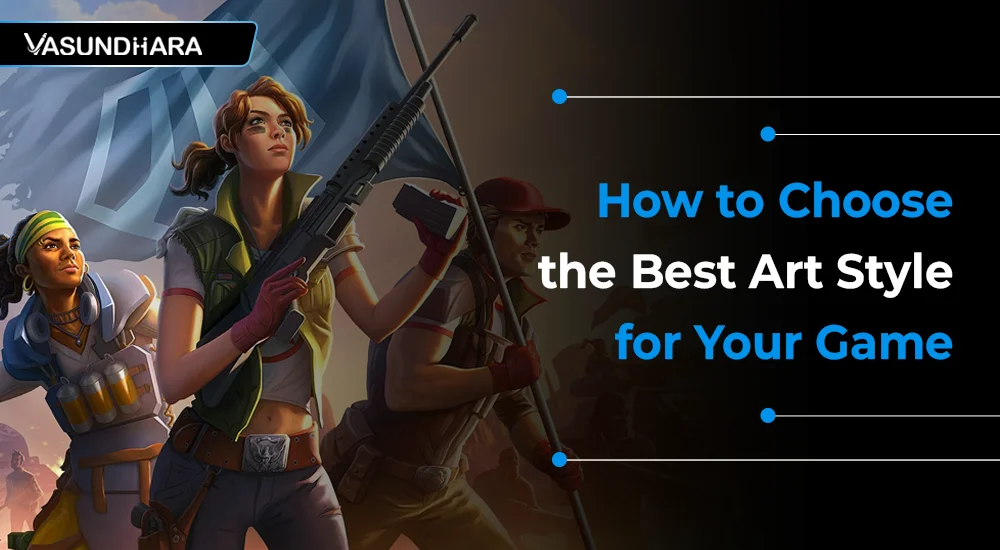A successful video game requires a combination of compelling gameplay, captivating storylines, and (with emphasis) immersive visuals. The art design is a vital component that contributes to the whole gaming experience; therefore, knowing how to select an art style for a game is critical for the creative process and the subsequent reputation of a digital experience.
The art style establishes the tone, elicits emotions, and impacts gamers indelibly. It can be the sole driving force and selling feature of a game. A premier art and animation company can help you choose the right game art style and make your game stand out in the highly competitive world of video games.
In this blog, we will look at the major factors and methods to assist you select an art style for a game.
What is Game Art Style?
The visual aesthetics and design decisions that determine the appearance of a video game are referred to as "game art style." It incorporates various components, including character design, environments, textures, colors, and the overall artistic direction. The game art designs can vary from realistic to abstract, including genres such as pixel art, cel-shaded, cartoonish, or photorealistic. The game's atmosphere, storytelling, and user immersion are all influenced by the art style selected. It is also consistent with the game's themes, gameplay mechanics, and target audience.
The impact of custom 2D/3D art in marketing and gaming is significant, as it not only enhances brand recognition but also captivates audiences with visually striking and unique content. Effective game art styles enhance the visual experience, rendering the game memorable and distinctive. The grim, realistic setting of "The Last of Us" and the vibrant, whimsical world of "The Legend of Zelda: Breath of the Wild" are two notable examples.
Also read: How to Make A 2D Art For Games
The Importance of Choosing The Right Game Art?
Choosing the right game art is crucial for several reasons. Firstly, it sets the tone and atmosphere, creating an immersive experience that resonates with players. The art style can evoke specific emotions, making the narrative more compelling and enhancing the gameplay experience. For example, a dark, gritty art style can amplify a horror game's tension, while a bright, whimsical design can make a platformer more engaging and fun.
Secondly, a distinctive art style helps a game stand out in a crowded market, attracting potential players and building a unique identity. Consistency in art style also ensures a cohesive look and feel, essential for maintaining immersion and credibility.
Moreover, the right art style can optimize performance across different platforms. For instance, a stylized, low-poly art style can be more efficient for mobile devices than high-fidelity graphics.
Ultimately, the right game art enhances storytelling, engagement, and marketability, contributing significantly to a game's success. Want to outsource the game art? Get in touch with our expert team at Vasundhara Infotech, a leading game art outsourcing Studio in India.
Understanding Art Styles
Game art styles are visual representations of the game that include the design of character art styles and the creation of environments. Each has its own distinctive character and appeal, ranging from realistic depictions to abstract concepts. Examples that are frequently cited include:

Aiming for photorealism or near-photographic precision, this style is commonly utilized in first-person shooters (FPS) and open-world adventures such as Red Dead Redemption and The Witcher.
Cartoonish style, which emphasizes exaggerated proportions, bright colors, and simple shapes, is common in platformers like Super Mario Bros. and Crash Bandicoot.
Low polygon counts and flat shading techniques are used to produce a distinct look, as seen in titles such as Minecraft and Terraria.
Inspired by classic 8-bit consoles, pixel art uses small squares organized together to produce graphics, as seen in retro throwbacks such as Shovel Knight and Celeste.
Stylized art styles combine elements from several genres, resulting in flexibility and variety, as seen in games such as Breath of the Wild, Overwatch, and Apex Legends.
Factors To Consider When Choosing An Art Style
There are numerous variables to evaluate when selecting an art style for your video game. These consist of:
Your artwork should be engaging and alluring to your intended audience. For example, a bright and colorful design would be more suitable if your target audience is children. Nevertheless, a more sophisticated and mature approach would be appropriate if your target audience is adults. Additionally, the art style should be more intricate and sophisticated to appeal to the interests and abilities of advanced game developers if your game is intended for them.
The art style of your game is also significantly influenced by the genre. For example, a dark and ominous design would be more appropriate for a horror game. Conversely, a whimsical and vibrant aesthetic would be optimal for a fantasy game.
Your game's art style can also be determined by the storyline. A realistic design would be more suitable for a game with a severe and emotional storyline. Nevertheless, a cartoonish or stylized design would be more appropriate for a more lighthearted and playful game.
Additionally, it is crucial to evaluate the technical capabilities of your development team and the platform for which you are developing. Certain styles necessitate more sophisticated technical abilities and may not be practicable for your team or platform.
Final Thoughts
Choosing the best art style for your game carefully considers various criteria, including genre, target audience, narrative, technological constraints, development time, and money. By researching existing games, sketching concepts, running prototype tests, and collaborating with artists, you may find the perfect art style to bring your game concept to life and captivate players at every turn.
We are seasoned professionals in the gaming, technology, and entertainment sectors. At Vasundhara Infotech, we provide various services, such as game development, game art, and complete 3D animation services. Our primary objective is to offer a comprehensive solution for any undertaking. If you want to leverage our expertise and experience in creating game art and other media, please do not hesitate to contact us. Let us collaborate to create something truly magical!




